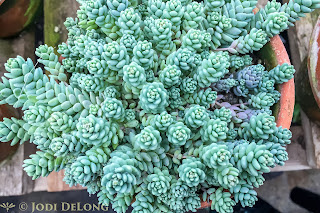It's been close to 40 years since I first fell for succulents in a big way. Probably the first one I ever saw would have been the common but beloved Jade tree, Crassula argentea, although I cannot be sure of this. I know I was smitten with them when I was in my first year at the Agricultural College, and that smitten-ness has never waned. Back then, there were a number of succulents including several massive jade trees growing in one of the greenhouses, and I learned how to propagate these easy, colourful and rewarding plants for myself.
I remember the challenges I had finding a lot of different types in stores, and the challenge of finding just the right container to make a 'dish garden' of succulents and cacti. It was also a challenge to grow these plants in a dorm room, but since I usually had dozens of plants in my room, I persevered. Some died. Some prospered.
Flash forward to today, and the popularity of succulents has come surging back in recent years. There are so many genera, and species, and varieties, so many colours and textures and forms...they're hard to resist! Or so I tell myself as I look around my house, where dozens of plants are waiting for warm weather so they can bask outside for a few months.
Here's an example of some of the great colours--succulents aren't 'just' green! This is related to the faithful jade tree, a different species, cultivar 'Campfire'. Look at that colour...
I also love cacti, although I don't have nearly as many as I do succulents. All cacti are succulents, but not all succulents are cacti--the term 'succulent' refers to any plant with the ability to store water in specialized tissues for long periods of time. And although you may think of succulents and cacti as being plants of deserts and other hot, dry areas, the truth is there are species found in many different climates, and numerous species that are hardy to Atlantic Canada. I have an opuntia (prickly pear) cactus that is hardy here, and numerous sedum and sempervivum varieties grow outside in my gardens. But I find the more exotic and tender species more alluring, which is why I have a houseful of them.
Several of my cacti are flowering at the moment, which pleases me greatly. What does NOT please me, however, is the penchant that some succulent growers have for gluing strawflowers onto their cacti to make it look like they are flowering. Then there are the dyed ones, but that's just so appalling I can't even rant about it.
The yellow-flowered succulent in the clay pot (photographed last year) is a Aichryson laxum, tree of love. Apparently, this plant is a biennial and dies after flowering unless deadheaded. The plant I have has not got that memo, because it has never stopped flowering since last summer, and today I trimmed all the scraggly flowers off it and put it outside for a few hours to wash it off and rejuvenate it.
This is Kalanchoe tomentosa, also known as the panda plant, which is one of those succulents I've known and loved forever. I try to keep it far away from my cats, or else it will become the cat-hair-panda-plant!
One of the many charms that succulents hold for me is their patterning. They grow in spirals, called Fibonacci spirals or the golden spiral, due to some mathematical stuff that makes my head hurt, so I just say they grow in spirals and aren't they awesome? Other plants exhibit this as well--think of the seeds in a sunflower, or the cones of evergreens, the petal arrangement of a double rose, and so on. They please me--maybe if someone had pointed this out to me when trying to drill math and geometry into my head, I would have done better at it!
This tree of succulents is on display in the greenhouse at my friend Alice's Ouest-ville Perennials, and is made up of a number of different succulents, planted into moss wired around an inverted tomato cage. I love it, although it has to be freshened up in the spring as the large echeveria rosettes can get straggly looking over winter.
What about you? Do you have a fondness for succulents?














